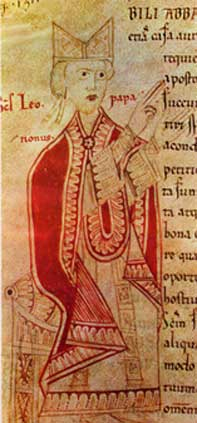
Back Pous Leo IX Afrikaans ليون التاسع Arabic ليون التاسع ARZ Леў IX Byelorussian Лъв IX Bulgarian Leon IX Breton Lleó IX Catalan Gáu-huòng Leo 9-sié CDO Lev IX. Czech Leo IX. German
Leo IX | |
|---|---|
| Bishop of Rome | |
 Miniature of Leo IX contained in an illuminated manuscript of the 11th century | |
| Church | Catholic Church |
| Papacy began | 12 February 1049 |
| Papacy ended | 19 April 1054 |
| Predecessor | Damasus II |
| Successor | Victor II |
| Previous post(s) | Bishop of Toul (1026–49) |
| Personal details | |
| Born | Bruno von Egisheim-Dagsburg 21 June 1002 |
| Died | 19 April 1054 (aged 51) Rome, Papal States |
| Sainthood | |
| Feast day | 19 April |
| Venerated in | Catholic Church |
| Canonized | 1082 by Pope Gregory VII |
| Other popes named Leo | |
Pope Leo IX (21 June 1002 – 19 April 1054), born Bruno von Egisheim-Dagsburg, was the head of the Catholic Church and ruler of the Papal States from 12 February 1049 to his death in 1054.[1] Leo IX is considered to be one of the most historically significant popes of the Middle Ages; he was instrumental in the precipitation of the Great Schism of 1054, considered the turning point in which the Catholic and Eastern Orthodox Churches formally separated.
Leo IX favoured traditional morality in his reformation of the Catholic Church. One of his first public acts was to hold the Easter synod of 1049; he joined Emperor Henry III in Saxony and accompanied him to Cologne and Aachen. He also summoned a meeting of the higher clergy in Reims in which several important reforming decrees were passed. At Mainz, he held a council at which the Italian and French as well as the German clergy were represented, and ambassadors of the Byzantine emperor were present. Here too, simony and clerical marriage were the principal matters dealt with. He is regarded as a saint by the Catholic Church; his feast day is celebrated on 19 April.[2]